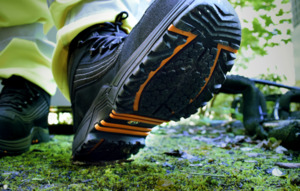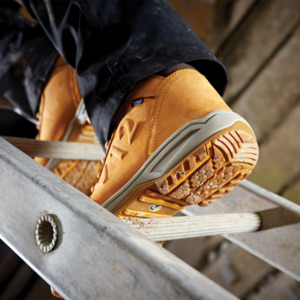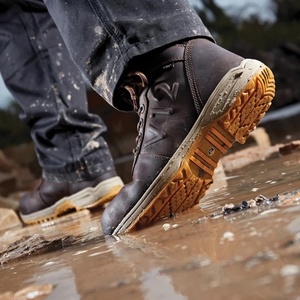
 |
Mark Sennett
Managing Editor |
 |
Kelly Rose
Editor |
| Home> | PPE | >Safety Footwear | >Innovations in foot health and safety |
Innovations in foot health and safety
24 April 2024
SAFETY FOOTWEAR is an element of PPE which has developed significantly over the last few years. With strides in innovation and development in material and components, pioneering technology can be found in many safety boot styles from heel to toe.

But true innovation in PPE isn’t about the level of technological development – it's about whether this innovation makes things safer and more comfortable for the wearer.
In this article, we’ll be focussing on some important innovations in safety footwear, and even more importantly, how they are driving up workplace protection and well-being.
A weight off the feet
Did you know? A person expends 5 times more energy carrying weight on their feet than carrying the same weight on their back.
Little wonder then that there are so many foot health and comfort complaints from work boot wearers, many of whom walk up to 14,000 steps per day in heavy boots. Making footwear lighter should be a key focus for Health and Safety Managers, as it’s a way of increasing comfort without compromising on protection.
Many manufacturers are finding ways to use lighter materials to make precious weight savings in their safety boots, such as the use of the much lighter EVA material in mid-layers, or incorporating PU in outsoles to replace heavier rubber. As well as this, non-metal materials such as fibreglass are becoming popular alternatives to steel toecaps and midsoles. Added to their lighter weight, they are also thermal-insulating, don’t trigger alarms for those working around security scanners, and because they undergo the same impact, compression and puncture resistance testing as steel toecaps and midsoles respectively, they are just as strong.
These elements by themselves might on paper appear to have nominal impact, but a boot designed and built with these strategic weight saving designs in tandem can create a significantly lighter boot, and significantly healthier feet.
Gripping not slipping
Slips at work are still at an all-time high. The latest HSE statistics show slips, trips and falls on the same level remain the leading cause of non-fatal injury to workers, accounting for 32% of all injuries. Thankfully, there are more and more ways to innovate slip safety to protect wearers.
Surface-specific tread is being developed, for example for man-made surfaces or looser natural terrain - and some manufacturers are going even further into the science of safety. Safety footwear manufacturer V12 Footwear conducted research which showed the angle at which most slips occur is 7°, and that commonly, these slips happen when the heel is placed down to make a new step. So, they designed their IGS and STS soles with a 7° heel strike, specifically to reduce slips and falls, and keep the wearer stable and slip-free.
Water repellence
Ensuring boots can guard the feet from water is crucial. After all, wet feet aren’t just an irritation: they can cause a variety of foot health issues. The key focus of how waterproof membranes can be innovated is to provide breathability and keep feet cool when they are enclosed in an additional lining. If this lining is not breathable enough, this can cause sweaty feet, so if the wearer’s feet aren’t wet from rain or puddles, then without the right membrane, they will be just as wet from inside-boot perspiration.
Thankfully, innovations in materials are revolutionising breathability in footwear, from microscopic cooling holes designed to let moisture escape but prevent water getting in, to inside-boot cooling technology.
V12 Footwear’s waterproof membrane ‘V-Dri’ is a great example of this. This industry-leading lining features an ultra-wicking fabric, allowing moisture out of the boot more quickly when the foot gets warmer. So, if temperatures are high, this intelligent and dynamic membrane ensures the resulting heat and sweat is removed faster.
Fastening
Fastening systems are becoming increasingly advanced and varied in safety footwear. As well as laces and zip-sides, micro-adjustable dial systems can also elevate the technology in a boot, and critically, elevate comfort and safety too. These advanced fit and fastening systems can reduce pressure points if the wearer has a foot health issue such as a blister or wound, and it also enables fastening to be adjusted without the need of glove removal.
Likewise, large zips are appearing on safety boots for the same reason; enabling boot fastening or removal without the wearer having to remove gloves, which is not only more convenient, but also a far safer option where hand protection is required.
And that’s the whole point of safety innovations – they shouldn’t progress the product, they should progress protection. And if you remember that when exploring safety footwear options for your teams, then you’ll be using it in exactly the right way.
To find out more about their innovations for foot health and safety, visit V12 Footwear.com
- V12's award-winning carbon neutral safety boot
- Sustainability matters
- True women's fit
- Do you want to up your safety footwear knowledge
- Weight-reducing innovations in safety footwear
- Award-winning sports range
- New safety footwear for women launched
- Metal-free footwear for men and women
- Best fit forward
- V12 supporting women in engineering


























